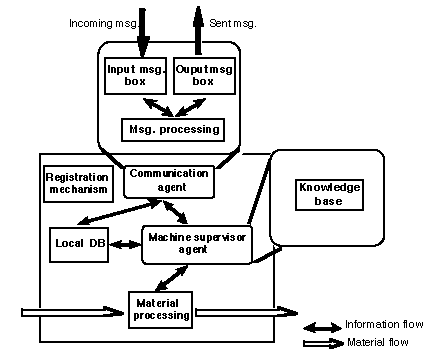Distributed Manufacturing, Extended Enterprises
by László Monostori and Botond Kádár
Management of complexity, changes and disturbances is one of the key issues of production today. Distributed, agent-based structures represent viable alternatives to hierarchical systems provided with reactive/proactive capabilities. In extended enterprises with other words within inter-enterprise integration, processes and activities from different, self-interested companies are integrated crossing enterprises and organisational boundaries. Agent-based manufacturing offers a promising way to model and control not only shop floor level activities but whole, perhaps, extended enterprises as well. In order to answer some key questions of agent-based manufacturing, an object oriented simulation framework for modeling and evaluation of multi-agent manufacturing architectures is under development at SZTAKI.
Manufacturing systems operate in a changing environment rife with uncertainty. Difficulties arise from unexpected tasks/events, nonlinearities, and a multitude of interactions during attempting to control various activities in dynamic shop floors. Growing complexity is another characteristic of today's manufacturing which manifests itself not only in manufacturing systems, but also in the products to be manufactured, in the processes, and in the company structures. This complexity and uncertainty seriously limit the effectiveness of conventional control and scheduling approaches.
In the field of manufacturing systems, decomposition of systems into smaller units (eg manufacturing cells) is a usual way to overcome the mentioned difficulties. In the last few years some new control and organisational architectures were proposed for this purpose, among others things fractal, bionic, random, and holonic manufacturing to mention only the most important ideas.
In addition to the significant advantages provided by multi-agent manufacturing systems, there are fundamental questions which must be answered during their design phase:
- internal structure of agents and the level of their self- containment
- communication: communication protocol, common interchange language
- group formation: negotiation, persuasion of machines to participate in a group, reward/penalty systems, market mechanisms, agents' objective function.
- reconfigurability: system openness (machine addition, deletion, substitution).
- scalability: potential appropriateness for scaling up to the level of the extended enterprise
- global versus local optima: how to reach global optima with selfish agents pursuing their own goals, which is the optimal ratio of hierarchy and heterarchy in a given situation, how to tune the system, how to accomplish learning at system and agent level?
These and similar questions can be answered only by extensive simulation. In the following, the main features of the object oriented framework for evaluation of distributed manufacturing architectures being developed at SZTAKI are described.
The framework provides a root model that represents a plant which can contain different manufacturing agents. The object library incorporates two main agent objects, ie machine agent and plant supervisor (order) agent. A plant in the model will contain only one order agent which is responsible for order processing, job announcements and job dispatching between different machines or groups. A model may include several machine objects which can be initialized during construction (the name of the machine, capable processes for this machine, etc).
Following the holonic type structure, agent objects contain different, functionally separated subagents. Each agent in the framework has a communication subagent, through which it can send and receive messages using a modified version of the contract net protocol. Each machine agent involves a machine supervisor subagent which controls its actions (see Figure). All agents contain a registration mechanism through which they register and unregister themselves automatically. Each agent has a local data base. Information about machine capability, allocated time intervals for different jobs, groups in which the agent is interested, etc, are stored here. Any information concerning the agent itself can be accessed only through the communication subagent by a request message. Only one information provider is treated centrally in the system, ie the registration book.

Figure: Structure of machine agent.
Each order actually arrived to the plant is checked by the order agent whether the plant is capable of producing the parts. If the machines in the plant as a whole, do not have the potential to complete a part, the part will be refused else the job will be announced. In the latter case each machine can bid for a job and can announce subjobs for other machines if it cannot cover all processes. All machines which have free resources for a job can bid. The most appropriate bid will be selected by order agent.
The framework provides transportation objects with which different routes for automated guided vehicle (AGV) can be defined. The functioning of the developed system can also be examined visually.
Further step is to extend the simulation towards extended enterprises, ie to investigate the scalability of agent based manufacturing architectures. However, whatever model will be selected, practical applications require the general techniques of electronic commerce, to obtain the trust of potential firms.
The project is partially supported by the National Research Foundation, Hungary. A part of the work was covered by the PHARE TDQM Program of the European Union and by the National Committee for Technological Development which promotes Hungarian research activity related to the ESPRIT Working Group on Integration in Manufacturing and Beyond.
Please contact:
László Monostori, Botond Kádár - SZTAKI
Tel: +36 1 1665644
E-mail: laszlo.monostori@sztaki.hu,
kadar@sztaki.hu
